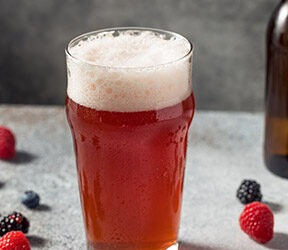Using Roasted Barley: Tips from the Pros
From red ale to porter, stouts to your favorite holiday brew, roasted barley is a dark specialty grain with zip and pizzazz. Use it for color, added sweetness and fermentable sugar, or simply for matters of taste. It’s no magic bullet, but this venerable grain is a serious weapon to add to your homebrew arsenal.
Brewer: Peter Licht, Coast Range Brewing Company in Gilroy, CA
Most brewers have some familiarity with roasted barley. It is one of the very darkest grains used and is characterized by an intense, roasty aroma. I find it to be reminiscent of French roast coffee beans. In fact, roasted barley and French roast coffee are actually produced in a similar manner. The unmalted barley grains are churned in a roasting drum and heated nearly to the point of combustion.
Roasted barley is available in a range of colors from 350–550 Lovibond. As you might expect, the intensity and character of the grain varies with the color. The darkest of the roasted barleys — in the 550 ºL range — are the classic grain for the dark character of stouts, especially Irish dry stouts.
If you want to produce a black, almost opaque beer, the minimum amount of dark roasted barley that you want to use is 7% of the grist. You can increase this up to 15% and will find that as you do so, the roastiness of the beer will also increase. Using more than 10% will give more of a smoky, burnt profile. This is a characteristic that is more common in American microbrewed stouts rather than Irish dry stouts.
Roasted barley has an acidifying effect on the mash. Because of this, brewers tend to treat the mash with calcium carbonate to keep the pH in the proper range. The proper mash pH is about 5.2–5.5 for almost all beers. Stouts, due to the dark grains, will tend to be on the lower end.
It is no mystery why cities with naturally carbonate water (such as Dublin, London and Munich) are known for dark beers — the water keeps the pH in balance despite the acidifying qualities of the darker grains, resulting in outstanding brews.
Roasted barley can also be well employed by extract brewers. All they have to do is steep the grains in the kettle. If I were making an extract brew that would benefit from a fresh roasted barley character, I would steep the whole grains in the kettle prior to to the boil for 5–15 minutes in a sack, or nylon stocking. I would recommend keeping the water between 160 and 175 ºF (71–79 ºC).
Brewer: Harley Smith, Longwood Brewpub in Nanaimo, BC
There are three basic types of roasted grains: chocolate malt, black patent malt and roasted barley. Roasted barley is unlike the other two grains because it is made from unmalted barley.
Raw barley goes directly into the roaster and is heated to temperatures as high as 446 ºF (230 ºC). The length of roasting time determines the darkness of the grain. This can vary from 250–600 ºL. It is during this roasting process that all the unique flavor profiles of roasted barley are produced. The most predominant characteristic is nutty and coffee-like.
Of the three dark malts, roasted barley produces the lightest colored head. This is one of the characteristics that makes roasted barley an excellent choice for brewing dry Irish stouts.
In dry stout, the focus of flavor is roasted barley. It is rumored, for example, that the Guinness (James Gate) brewery uses a combination of pale ale malt, flaked barley (30%) and roasted barley (10%) to achieve its legendary flavor. Simplicity is bliss!
A more balanced, dark malt attack should be used when making porter. Mix black patent and chocolate with your roasted barley. If the recipe calls for 9% dark malts, 3% chocolate, 3% black patent and 3% roasted barley will give you a good starting point for flavor comparison.
Another unique characteristic of roasted barley is the deep red mahogany color that it imparts in beer. For this reason, it is excellent when combined, in small quantities, with medium Lovibond caramel malt to produce red ales.
The rule of thumb for using any dark malt is “a little dab will do ya.” For nut brown ales, this means 2–4% of the total grist. For stouts and porters, use no more than 10%. If you overdue it, a sharp acrid and acidic flavor, not to mention a tar-like quality, will definitely challenge the consumer. It will also make balancing the hops difficult.
If you are not into all grain brewing, any specialty malt can be used in a steeping bag. Steep the grain at a ratio of 1 lb. (0.45 kg) to 1.5 quarts (1.4 L) of water at 150–160 ºF (66–71 ºC) for 20 minutes. This may not seem like a lot of water, but diluting the grain too much can leach tannins and acids into the water. Wringing out the bag will also have the same leaching affect.



